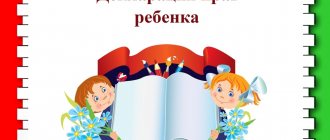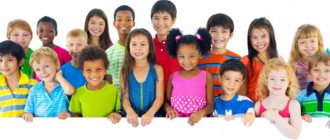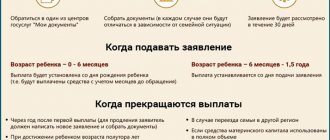Children's rights - international and Russian legislation
| International legislation on children's rights | Russian legislation on children's rights |
“Convention on the Rights of the Child” (approved by the UN General Assembly on November 20, 1989) (came into force for the USSR on September 15, 1990)“European Convention on the Exercise of the Rights of Children” (ETS N 160) [Russian, English] (Concluded in Strasbourg on 01/25/1996)“Convention on jurisdiction, applicable law, recognition, enforcement and cooperation in relation to parental responsibility and measures for the protection of children” (Concluded in The Hague on 19.10.1996) in Russian and English / official translation /.“Convention on the law applicable to child support obligations.” (as amended on November 23, 2007) Concluded in The Hague on October 24, 1956.Articles and useful information about the rights of a minor child | Family Code of the Russian FederationFederal Law of July 24, 1998 N 124-FZ “On the Basic Guarantees of the Rights of the Child in the Russian Federation.”Federal Law of December 29, 2010 N 436-FZ (as amended on May 1, 2017) “On the protection of children from information harmful to their health and development.”Decree of the President of the Russian Federation of April 13, 2011 N 444 (as amended on June 29, 2013) “On additional measures to ensure the rights and protection of the interests of minor citizens of the Russian Federation.”Resolution of the Plenum of the Supreme Court of the Russian Federation dated May 16, 2021 N 16 “On the application of legislation by courts when considering cases related to establishing the origin of children.”Resolution of the Plenum of the Supreme Court of the Russian Federation dated November 14, 2017 N 44 “On the practice of courts applying legislation when resolving disputes related to the protection of the rights and legitimate interests of a child in the event of an immediate threat to his life or health, as well as when restricting or depriving parental rights.” |
Chapter 11. RIGHTS OF MINOR CHILDREN
(Extract from the “Family Code of the Russian Federation” dated December 29, 1995 N 223-FZ)
Article 54. The right of a child to live and be raised in a family
1. A child is a person who has not reached the age of eighteen years (the age of majority).
2. Every child has the right to live and be raised in a family, as far as possible, the right to know his parents, the right to their care, the right to live together with them, except in cases where this is contrary to his interests.
A child has the right to be raised by his parents, to ensure his interests, comprehensive development, and respect for his human dignity.
In the absence of parents, in the event of deprivation of their parental rights and in other cases of loss of parental care, the child’s right to be raised in a family is ensured by the guardianship and trusteeship authority in the manner established by Chapter 18 of this Code.
Article 55. The child’s right to communicate with parents and other relatives
1. The child has the right to communicate with both parents, grandparents, brothers, sisters and other relatives. The dissolution of the parents' marriage, its recognition as invalid or the parents' separation do not affect the rights of the child. If the parents live separately, the child has the right to communicate with each of them. A child has the right to communicate with his parents also if they live in different states.
2. A child in an extreme situation (detention, arrest, detention, being in a medical institution, etc.) has the right to communicate with his parents (persons replacing them) and other relatives in the manner prescribed by law.
Article 56. The child’s right to protection
1. The child has the right to protection of his rights and legitimate interests. Protection of the rights and legitimate interests of the child is carried out by parents (persons replacing them), and in cases provided for by this Code, by the guardianship and trusteeship authority, the prosecutor and the court. A minor, recognized in accordance with the law as fully capable before reaching the age of majority, has the right to independently exercise his rights and obligations, including the right to defense.
2. The child has the right to protection from abuse by parents (persons replacing them). In the event of a violation of the rights and legitimate interests of a child, including in the event of non-fulfillment or improper fulfillment by parents (one of them) of the responsibilities for the upbringing, education of the child, or in the case of abuse of parental rights, the child has the right to independently apply for their protection to the guardianship and trusteeship authority, and reaching the age of fourteen years in court.
3. Officials of organizations and other citizens who become aware of a threat to the life or health of a child, a violation of his rights and legitimate interests, are obliged to report this to the guardianship and trusteeship authority at the place of the child’s actual location. Upon receipt of such information, the guardianship and trusteeship authority is obliged to take the necessary measures to protect the rights and legitimate interests of the child.
Article 57. The right of the child to express his opinion
The child has the right to express his opinion when deciding any issue in the family that affects his interests, as well as to be heard during any judicial or administrative proceedings. Taking into account the opinion of a child who has reached the age of ten is mandatory, except in cases where this is contrary to his interests. In cases provided for by this Code (Articles 59, 72, 132, 134, 136, 143, 145), the guardianship and trusteeship authorities or the court can make a decision only with the consent of a child who has reached the age of ten years.
Article 58. The child’s right to a first name, patronymic and last name
1. The child has the right to a first name, patronymic and last name.
2. The child’s name is given by agreement of the parents, the patronymic is assigned by the father’s name, unless otherwise provided by the laws of the constituent entities of the Russian Federation or based on national custom.
3. The child’s surname is determined by the surname of the parents. If the surnames of the parents are different, the child is assigned the surname of the father or the surname of the mother by agreement of the parents, unless otherwise provided by the laws of the constituent entities of the Russian Federation.
4. In the absence of an agreement between the parents regarding the first and (or) last name of the child, the disagreements that arise are resolved by the guardianship and trusteeship authority.
5. If paternity has not been established, the child’s name is given at the direction of the mother, the patronymic is assigned by the name of the person recorded as the child’s father (clause 3 of Article 51 of this Code), and the surname is assigned by the mother’s surname.
International legal protection of children's rights
Pages: 1
Table of contents
- Introduction
- Chapter 1. Concept and development of international legal protection of children’s rights
- 1.1. Concept and features of international legal protection of children's rights
- 1.2. Formation and development of international protection of children's rights
- Chapter 2. Legal and institutional mechanism for international legal protection of children's rights
- 2.1. International instruments as a legal mechanism for protecting children's rights
- 2.2. UN Institutional Mechanism for the Protection of Children's Rights
- Chapter 3. Current problems of special international legal protection of children's rights
- 3.1. Protecting children's rights from harmful traditional practices around the world
- 3.2. Current problems of child labor exploitation in the world
- 3. International protection of children from sexual exploitation
- 3.4. Problems of protecting children's rights in armed conflicts
- Conclusion
- Bibliography
Introduction
The United Nations declared in the Millennium Declaration that the international protection of children's rights is one of the six global challenges of the third millennium.
In the legal status of children for more than two millennia, the only protection was the remnants of Roman law, the “parental authority of the father.” Over a long period of time, the international community has significantly improved legislation, but, nevertheless, left the child without legal protection. The awakening of the international conscience in the twentieth century demanded the recognition and protection of children's rights throughout the world.
“A child is an independent person, has his own interests and rights that must be respected.” The main proponent of the new concept of childhood between the world wars was a citizen of Poland, doctor of medical sciences, writer and philosopher Janusz Korczak. Having the opportunity to escape, he remained in the Nazi concentration camp Treblinka with his children and died in a gas chamber in 1942. In 1978, the Government of Poland, in an effort to popularize Korczak's ideas and perpetuate his memory, initiated the process of developing the Convention on the Rights of the Child.
In 1989, the United Nations adopted the Convention on the Rights of the Child, which received unprecedented distribution compared to other international instruments. In 2015, South Sudan and Somalia acceded to the Convention on the Rights of the Child. It can be stated that in the new millennium, 195 countries of the world, where 97% of all children live, have ratified the Convention on the Rights of the Child. Only one UN member state, the United States, has signed but not yet ratified the Convention on the Rights of the Child (82).
All children have the right to protection. They have the right to life to be safe, to have an identity, to be heard, to receive proper care and to grow up in a safe environment. The family is the first line of defense for children. Parents or others are responsible for providing a safe and loving home environment. Schools and communities have a responsibility to create a safe and supportive environment for children outside the child's home. In the family, school and community, children must be fully protected so that they can survive, grow, learn and develop to their fullest potential.
The international community is concerned about the implementation of legal instruments to protect children's rights in the world. The United Nations has created special bodies for activities aimed at ensuring international legal protection of children's rights: the UN Committee on the Rights of the Child and the UN Children's Fund (UNICEF), protection is also carried out by other institutional mechanisms of the UN.
However, millions of children around the world are not fully protected. Many experience violence, abuse, neglect, exploitation, exclusion and discrimination every day. Such violations limit their chances of survival, growth, and development.
The closest attention of the international community is aimed at consolidating and implementing international standards for special measures to protect children from harmful traditional practices, sexual and labor exploitation, abduction, violations of bioethics, and violations of children’s rights during hostilities.
We are greatly encouraged by the unified efforts of all countries to protect children's rights under the auspices of the UN Convention on the Rights of the Child. However, approaches to the problem of international legal protection of children’s rights are far from unambiguous; in many countries, the imposition of the American-European image of an “ideal childhood” is criticized. However, the relevance of building a world fit for children is undeniable. Thus, the choice of the topic of final qualifying research is determined by the need for a comprehensive study of this problem in the modern science of international law.
Despite the fairly high public interest in the problem of international legal protection of children’s rights, it should be noted at the present stage that there is a clear lack of development of the chosen topic in the Russian science of international law. It is noteworthy that certain issues of the topic were covered in Russia in the dissertation research of applicants from abroad: Belarus, Mongolia, Poland. Also of interest is the work on studying the implementation of international treaties of the Russian Federation using the example of interaction with Scandinavian countries in the field of protecting children’s rights, published in 2013. These works, as well as other works of scientists, both in the field of international law and related legal sciences, political science and pedagogy, dedicated to the international protection of children's rights, formed the theoretical basis of the final qualifying work.
The object of study was the complex of legal relations emerging in the international practice of protecting children's rights. The subject is the norms of international law in the field of international legal protection of children's rights.
The purpose of the final qualifying work was a comprehensive consideration of the international legal protection of children's rights. Objectives of the qualification study:
-study the concept of international legal protection of children’s rights;
-cover the formation and development of international protection of children’s rights;
-consider international acts as a legal mechanism for protecting children’s rights;
— study the institutional mechanism for the international protection of children’s rights;
— consider the problems of international legal protection from harmful practices;
— highlight special measures to protect against labor exploitation of children;
-highlight the problems of international legal protection of children in armed conflicts.
The work used the universal dialectical method and methods of logic. The following special research methods were used: formal legal, historical and legal, comparative legal methods. In addition, specific sociological and statistical methods were used.
The normative basis for the study was made up of international legal acts on the rights of the child and their protection of a universal and regional, general and special nature. The empirical basis of the work is based on a synthesis of the experience of: the United Nations and its divisions, in particular the Committee on the Rights of the Child, the Children's Fund (UNICEF), and international non-governmental human rights organizations.
The theoretical and practical significance of the study lies in the fact that it covers one of the most important topics of international law and thereby complements legal science. The provisions and recommendations in the study can be used in the work of practitioners who protect children's rights. The work can also become the basis for a special course in teaching international law.
The research materials were discussed at the “Annual Scientific and Practical Student Conference of BSU -2016”.
The thesis consists of an introduction, three chapters, a conclusion, and a bibliography.
Chapter 1. Concept and development of international legal protection of children’s rights
1.1. Concept and features of international legal protection of children's rights
The world community realized the planetary significance of the problem of protecting children's rights after the Second World War, and at the end of the twentieth century, the international legal protection of human rights developed most intensively. From a purely national problem, this problem began to turn into an international one, as a result of which the law of all countries gradually began to fall under the influence of international standards. It is now generally accepted that the rights of children, no matter what country they live in, are protected not only by the constitution and the entire legal system of their country, but also by the entire world community.
International protection of the rights of the child is an integral part of the international protection of human rights, therefore almost all of its provisions are applicable to it. At the same time, the separation of issues related to the rights of the child into an independent subject within the framework of international protection of human rights is caused, first of all, by objective reasons: firstly, as a result of a number of historical conditions, the social status of children is lower than adults, and international protection children's rights is aimed at ensuring them equal rights and opportunities with adults; secondly, due to physical and mental immaturity, the child needs special rights and additional protection.
The overall thrust of international action for children is the moral and legal recognition of their emotional, physical and psychological vulnerability, their need for special care, and the obligation to respect and ensure their rights, including the right to expression. These issues reflect the value of society valuing children for their own sake rather than as a launching pad for adulthood. At the same time, we must recognize that all events in childhood greatly influence the adult and, therefore, society as a whole. A key concept in international legal protection of children's rights is that children - as individuals - have rights, and these must be enumerated, legally binding and specified for the child's development.
As T.A. rightly notes. Titov, the development of mechanisms for international legal protection of children did not have its own deep philosophical and humanitarian traditions. In the last quarter of the 20th century, there were only two opposing theories in science regarding the essence of children's rights - protectionism and liberalism. Protectionism or paternalism views childhood as a period of complete dependence and extreme helplessness, liberalism, on the contrary, as a period of child independence.
The modern international legal mechanism for the protection of children reflects a special concept of the rights of the child - liberal paternalism. Liberal paternalism views childhood as a step-by-step process of child development from strong dependence (infancy) to independence (adulthood). The adult's task is to help the child gradually gain independence in thoughts and actions. Thus, the power of parents and those caring for the child is of a targeted nature, that is, it is aimed at developing the child’s self-awareness and ability to self-determination, after which they lose it.
The rights of children as individuals are closely linked to the rights of others. Most human rights are granted to adults and are assessed on the basis of the rights and responsibilities of the individual. While recognizing and indeed emphasizing that children as individuals are subjects of law, it should also be noted that children's rights are closely linked to the rights of others who are significant to them. Broadly speaking, this happens in two ways:
Basically, the protection of adult rights is based on the concept of ensuring that an adult has the opportunity to make decisions that will affect the protection of rights, or has the opportunity to present their point of view. The Refugee Convention, for example, provides that everyone has the right to return to their country, but the ability to exercise this right depends on the refugee having all the necessary information and understanding to make that decision. A child obviously cannot make such decisions and depends on older people. Older children have different opportunities for decision-making, according to their individual characteristics and according to their age, and also depend on adults to protect their rights, although to varying degrees. More broadly, the effective protection and promotion of children's rights can often be closely linked to the effective protection and promotion of the rights of those adults on whom the child depends. For example, when an adult refugee who is responsible for 3 children is arbitrarily detained, the rights of the 3 children may well be violated as a direct consequence of the violation of the adult's rights.
Children enjoy numerous rights that are accompanied by the rights of the child's parents or other legal guardians. These may include a significant role for these individuals in making decisions in the best interests of the child. You need to be able to respect the rights of the child and promote your interests without infringing on the rights of adults. In a strict legal sense, the rights of parents and other guardians over children are limited to the best interests of the child.
The rights of children, unlike adults, can be caused more significant harm by the same violations. Interruptions in the development of children have a more negative potential and can affect them much more seriously than adults. An adult who lives in a situation of armed conflict, who is displaced from his home, who is unable to obtain regular employment, and who has suffered from malnutrition and abuse for 4 years can be expected to continue his life as normal after elimination reasons for his movement. The child experiences the same situation: may suffer lifelong stunted growth and mental development as a result of malnutrition and abuse; without access to school during displacement, one may never regain lost educational opportunities and thus be deprived of many future opportunities. It is clear that the same threats to the same rights of adults and children can have different effects. It follows that children require special types of protection and promotion of rights.
Given their age, children may be less able to protect themselves from violations of their rights, or even to take advantage of available remedies. In addition, specific situations or circumstances may be more dangerous for children than for adults. In fact, some disorders are experienced only by children. Pedophilia and the use of children in pornography, for example, are acts specific to children. Female genital mutilation is typically carried out on girls, whose young age prevents their views from being taken into account in decisions about whether or not such procedures should be carried out. Children in certain situations may find themselves subject to criminal liability even if they have not committed any crime. Sometimes this happens, for example, with children living on city streets or at railway stations.
There are a number of factors that can be said to significantly increase the vulnerability of most children to additional violations of their rights. These include insufficient access to education; difficult access to medical care; situations of armed conflict in the region in which the child lives; population movements; family breakdown; and extreme poverty. In particular, it should be noted that it is often a combination or sequence of different factors that create the greatest vulnerability; for example, a combination of poor education and population movements may be factors that exacerbate the spread of HIV/AIDS, which in turn contributes to family breakdown (where parents get sick and die) and leads to child poverty.
Some threats to children's rights may be more likely to affect girls than boys, or vice versa. For example, boys are more likely to be recruited as child soldiers, while girls are more likely to be victims of sexual exploitation by soldiers or armed opposition groups. Girls are more likely to become victims of forced early marriages. However, it is important to be careful when classifying risks by gender, as girls may be forced into military service and boys may be victims of sexual exploitation.
International legal protection is provided specifically for children; the world community is expanding this special legal mechanism. The need for special programs to meet the special needs of children as vulnerable communities is recognized.
The international legal system for the protection of children's rights is a set of interrelated legal mechanisms (for example, international acts) and institutional mechanisms (for example, international organizations) aimed at preventing and responding to violations of children's rights, lack of proper provision, exploitation and other forms of violence against children.
1.2. Formation and development of international protection of children's rights
The idea that children have or should have rights is of relatively recent origin. Historically, children were considered socially insignificant and were in a humiliated position. The children did not receive any special care or protection from the state. The use of children as political hostages and as collateral for debts is reflected in Babylonian history. In the ancient world, such phenomena as sexual abuse of children, child sacrifice, and female infanticide of illegitimate children were tolerated. Unwanted or weak children were considered a drain on the family and were often abandoned, sold into slavery or into prostitution. Childhood was considered an unimportant transitional period of physical and mental immaturity.
Parents enjoyed absolute rights over their children, rights of obedience, services and income, and complete control over their persons and property until the 19th century, which was due to the pervasive and enduring influence of the Roman law doctrine of "Patria potestas" (paternal authority). This Latin phrase denoted the totality of these powers and rights, which, according to Roman law, belonged to the father, as the head of the family, in relation to his wife and children.
According to historians, the concept of the emergence of “childhood” as a separate stage of life occurred relatively recently and is a European social construct. Before this there was little difference between children and adults. Public opinion against cruelty to children and concern for their physical and emotional well-being increased in the late 18th century and 19th century. A concept about childhood has been developed: children are increasingly separated from adult society, children participate more actively in the formal education system and are excluded from production.
The 19th century marked the recognition of children's legal status. An important condition for accepting the concept that children have rights as well as responsibilities is to strengthen the social status of children. The beginnings of the children's rights movement can be traced back to the mid-19th century, when Jean Valès tried to create a league to protect children's rights in the aftermath of the French Revolution. In 1852, an article entitled “Children's Rights” was published in the journal Slogvolk in the Netherlands.
Influenced by the growing perception of children as vulnerable and dependent, states are enacting special laws to protect the physical, mental and moral well-being of children. Previous legislation, even if it seeks to protect children from the harshness of the decision of the outside world, but it pursues a policy of minimal interference in the parent-child relationship.
Child welfare legislation introduced as a result of the Industrial Revolution introduced criminal sanctions and termination of parental rights in extreme cases of violation of parental responsibilities towards children. Compulsory education laws were introduced to provide children with basic general education and vocational training. Child labor was limited in terms of working hours and working conditions.
Advances in medicine, nutrition and psychology in the second half of the 19th century reaffirmed the view that children were not simply miniature adults, but had their own special characteristics and needs. By the end of the 19th century, in industrialized countries, children were removed from adult prisons, orphanages were established, and better medical treatment was provided for mentally retarded children. The state placed itself between the child and the family and limited the largely unlimited power of the father. This stimulated the demise of the notion that a father should always have custody of his children and the emergence of an undefined "best interests of the child" standard. Both parents have acquired a shared responsibility to raise and protect the child.
The international movement for children's rights began in the early 20th century. It is characterized by the internationalization and institutionalization of humanitarian ideals by groups such as the International Committee of the Red Cross, the League of Nations and the International Labor Organization. One of the first treaties to treat children as a group was the International Agreement for the Suppression of the White Slave Traffic, signed in Paris on May 18, 1904.
International advocacy for children's rights received further impetus in 1919 with the creation of the League of Nations and the International Labor Organization. The Treaty of Versailles was concluded on June 28, 1919 and in its preamble declared the protection of children and young people. The International Labor Conference at its first session adopted a convention on minimum age in industry and since then numerous conventions and recommendations have been adopted concerning the minimum age for employment in various occupations, as well as hours and conditions of work. Within ten years of its founding, the League of Nations adopted the International Convention for the Suppression of the Traffic in Women and Children of 1921 and the Slavery Convention of 1926.
In 1923, Eglantine Jebb, an Englishwoman, created the Save the Children Foundation and initiated the idea of a charter for children. The first Declaration of the Rights of the Child (commonly known as the Declaration of Geneva) was adopted by the League of Nations on September 26, 1924; among other things, the Declaration stated that the child should be provided with the means necessary for his normal material and spiritual development and children should be protected from all forms of operation.
The Geneva Declaration of 1924 did not create legal obligations for states. It was a declaration—a set of moral obligations. These were essentially aspirational standards. The League of Nations invited member states to be guided by the principles of social protection for children. It was therefore left to the discretion of each member state of the League to take appropriate measures within the limits of their resources and specific circumstances.
The drive to internationalize and institutionalize humanitarian ideals gained momentum with the creation of the United Nations in 1945. In 1946, the Economic and Social Council recommended that the United Nations General Assembly create a United Nations International Children's Emergency Fund (usually referred to as UNICEF) to help improve the lives of children whose countries were devastated by World War II. On December 11, 1946, the General Assembly established UNICEF in accordance with resolution 57. In 1953, it was made permanent and renamed the United Nations Children's Fund, retaining the acronym. In 1961, UNICEF's funding was increased to assist in education and training, child welfare and family planning. While UNICEF continues to provide assistance to children affected by war, drought, famine and other emergencies, its activities have expanded to include health and nutrition programs designed to combat high infant mortality, poor health and hunger among children in developing countries .
On November 20, 1959, the UN General Assembly unanimously adopted the Declaration of the Rights of the Child. The Declaration was the first international document to contain a comprehensive list of children's rights. Prior to the 1989 Convention on the Rights of the Child, the Declaration was embodied as the most important political statement on children and their rights.
While the 1924 Declaration of Geneva reflected concern for the material needs of children suffering from the devastation of the First World War, the 1959 Declaration of the Rights of the Child sought to address the needs and interests of children within a broader social welfare context, covering areas such as housing , social security, health and medical care, food and nutrition, education of every child, birthright regardless of nationality.
As a type of document, a declaration proclaims a set of principles or aspirational ideals that are generally accepted by governments and the international community, but do not constitute specific legal commitments.
Thus, the 1959 Declaration merely creates a policy commitment for government to provide for the care and protection of children through child welfare programs and other legislative and administrative measures. However, the widespread recognition in 1959 of the rights recognized in the declarations of the rights of the child marked a significant step towards their legal recognition 30 years later, in the Convention on the Rights of the Child.
Research conducted by UNICEF during the 1970s found that violations of children's rights were a global phenomenon, with international agreements largely ignored. The concept crystallizes that childhood is the most important period in human development and that children require special guarantees beyond those provided to the individual as an adult due to their physical and mental immaturity and consequent dependence and vulnerability. The belief that national legislation is insufficient to deal with this problem and the recognition that external intervention through common minimum international legal standards is necessary.
By 1976, UNICEF had become so concerned about the dire conditions of children around the world that its leadership petitioned the UN General Assembly to declare 1979 the “International Year of the Child.”
As one of its contributions to the International Year of the Child, the Polish government submitted the proposed text of a draft convention on the rights of the child to the UN Commission on Human Rights in early 1978, with a view to its adoption in 1979. The Polish initiative was inspired by the desire to transform the aspirational ideals of the 1959 Declaration of the Rights of the Child into legally binding international obligations. In addition to this initiative, a conference on the legal protection of children's rights was held in Warsaw in 1979, attended by participants from 19 countries in Western and Eastern Europe. Participants unanimously adopted various provisions regarding the legal protection of children's rights in areas such as education, health, recreation, child labor, refugee children and social protection.
The fact that the proposal came from Poland, at a time when the Iron Curtain still divided Europe into two different worlds, is often associated with the life and work of Janusz Korczak, a pioneer of child welfare who died in 1942 with orphans from the Warsaw Ghetto . Poland can also lay claim to a modern child rights hero in Adam Lopatka, sometimes called the “Father of the Convention on the Rights of the Child.” Polish international lawyer, diplomat, professor Adam Lopatka became the Chairman of the Working Group on the development of the Convention on the Rights of the Child. A collection of government representatives who met annually in Geneva between 1979 and 1988, the development process took almost a decade due to the strong social and legal differences between states.
The new idea that the child was recognized as a full member of society put an end to the centuries-old position that children belonged to their parents. It's amazing how strong this “set” was. When creating one of the rights of the child, the following formulation was proposed: “a child has the right from the moment of birth to know his parents and belong to them.” During the discussion, it was rejected as not meeting the main idea of the Convention.
The formation and development of international protection of children's rights reflects the gradual recognition by the world community of the characteristics of children as such: on the one hand, they are essentially people and should directly have rights; on the other hand, they need support from parents or persons in their stead, society, and the state, since they are socially vulnerable and do not have full legal capacity.
Pages: 1











